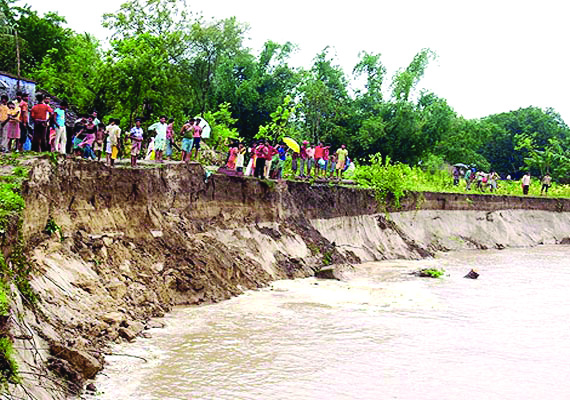Malda, Murshidabad districts hit by erosion: Mamata at National Ganga Council Meet

Kolkata: Bengal Chief Minister Mamata Banerjee raised the issue of the vulnerable condition of erosion-affected areas along the banks of river Ganga during the National Ganga Council (NGC) meeting held on Friday in Kolkata.
The meeting was chaired by Prime Minister Narendra Modi virtually.
Banerjee mentioned that Bengal comes under the Ganga region and hence is prone to river bank erosion. In every deltaic tract, river bank erosion occurs frequently and Bengal is no exception to the same. Erosion of the banks occurs usually during high tides and floods. "...In West Bengal, mostly Malda and Murshidabad districts face the problem," she stressed during the meeting.
The Chief Minister further added that in Malda district, Manikchak, Kaliachak I and II, Ratua I and II blocks were severely affected by river bank erosion. The CD blocks of Murshidabad district, including Farakka, Samserganj (especially Dhuliyan), Suti I, Suti II, Raghunathganj II, Lalgola, Bhagawangola I and II, Raninagar I, Raninagar II and Jalangi, have to encounter the problem year after year.
River Ganga has been causing significant bank erosion in Dhuliyan for many years. It has been found that erosion has intensified since the construction of the Farakka Barrage due to the barrage gates' limited functionality and the concentration of flow along the right bank.
In the middle of the 1970s, Dhuliyan and its surrounding territories suffered greatly. The failure of banks has consistently had an impact on Dhuliyan. Erosion poses a threat to the entire region. It is evident that the entire region of Dhuliyan is susceptible, particularly along the river bank, Banerjee emphasised. Besides, due to the proximity of their homes to the river bank — barely five metres away — thousands of lives are at risk. "The right bank of the river experiences more active erosion due to ongoing shifting of the bank with Dhuliyan being one of the most affected areas," the Chief Minister added.
People living along the bank of the Ganga in Dhuliyan have been suffering from erosion-induced problems for the past decades. The areas, along downstream of the Farakka Barrage, face the problem of erosion and population displacement. Banerjee further emphasised that the number of slums is growing as a result of ongoing population displacement along the river bank, which has resulted in a very high population density of 15,314 people per square kilometre, whereas, the state's population density is 1,029 people per square kilometre and the district of Murshidabad's population density is 1,334 people per square kilometre, according to the 2011 Census Report.
"Unhygienic and unplanned habitation has been created along the bank, where 25 to 35 people are living together in a small room in extremely poor condition as a result of the backward relocation of a large population caused by river bank erosion," she said.
"High proportions of residents in Dhuliyan town are in slum areas, and most of them live in appalling conditions along the river bank," Banerjee mentioned during the meeting.
The Chief Minister further talked about the Sunderbans Master Plan, a comprehensive initiative towards sustainable development of the mangrove biodiversity area with the primary objective of conservation of wildlife through breeding and nurturing of endangered species of the region.
"The master plan aims to integrate and develop tourism alongside fostering the biodiversity of the region. It also aims to further economic growth of the region through holistic development of the environment, especially from the perils of climate change and other natural calamities," she said.
The project includes the development of Henry's Island, Sagar Island, Frasergunj, Nakkhali, Susni Island, Bhagabatpur Crocodile Park, and Hamilton Island and community-level development of the Sunderbans, South 24-Parganas district.
The state is also going to witness the Gangasagar Mela on the occasion of Makar Sankranti. Every year, pilgrims from all over the world gather at Gangasagar for a holy dip at the confluence of the Bay of Bengal and River Ganga located off Sagar Island at the very southern reaches of Bengal.
Lakhs of devotees from across the world come to offer their prayers at the Kapil Muni Temple and take part in the pious rituals. Devotees come from countries like Nepal, Thailand, West Indies, Canada and Japan apart from all parts of India, the Chief Minister said.
The National Ganga Council has been responsible for the superintendence of pollution prevention and revitalisation of River Ganga and its tributaries. Namami Gange Programme is an Integrated Conservation Mission, approved as a 'Flagship Programme' by the Central government in June 2014 with a budget outlay of Rs 20,000 crore to accomplish the twin objectives of effective abatement of pollution, conservation and rejuvenation of the national river — Ganga.
The meeting was attended by Union Minister for Jal Shakti Gajendra Singh Shekhawat along with other Union ministers who are members of the Council besides Uttarakhand CM Pushkar Singh Dhami, Uttar Pradesh CM Yogi Adityanath, Jharkhand CM Hemant Soren and Mamata Banerjee.
Meanwhile, at the 46th meeting of the Executive Committee of the National Mission for Clean Ganga (NMCG), projects for the development of sewerage infrastructure in the Ganga basin were approved. Out of the approved projects, 12 pertain to the development of sewerage infrastructure in Uttar Pradesh, Bihar, Jharkhand, and West Bengal worth more than Rs 2,700 crore, a government communiqué confirmed.



